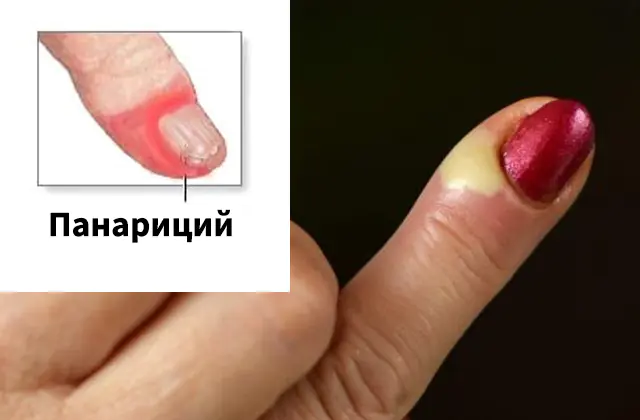
What is panaritium, causes, symptoms and classification of the disease. Traditional and folk methods of treatment, surgery. Complications and prevention.
The content of the article:- What is a panaritium on a finger?
- Reasons for development
- Symptoms and stages
- Treatment options
- Antibiotics
- Ointments
- Antiseptics
- Physiotherapy
- Surgical intervention
- Folk remedies
- Complications
Panaritium on the hand is an inflammation of the soft tissues of the phalanx of the finger. The disease is often caused by penetration of pyogenic microflora into a wound or scratch. Often inflammation develops on the thumb. If left untreated, the pathology can develop into gangrene.
What is a panaritium on a finger?
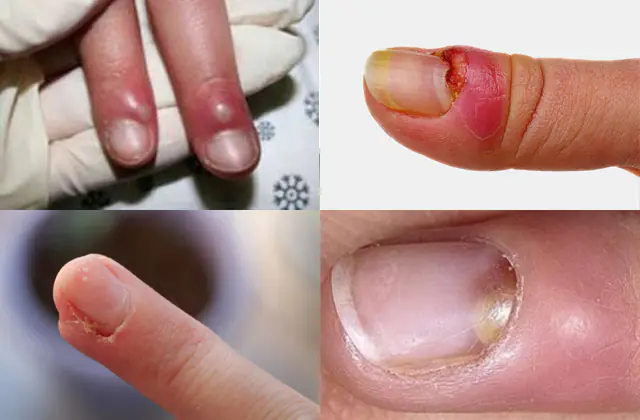
In the photo there is a panaritium on a finger
Finger felon is an infectious process that occurs in the soft tissues of the finger phalanx. Although the skin reliably protects the body from external influences, the slightest scratch or cut becomes a “gateway” for pathogenic microorganisms. Getting into the wound, they lead to inflammation with the formation of infiltrate. Gradually, infectious agents multiply and an abscess begins.
Although the connective tissue of the finger phalanges consists of individual cells with partitions that prevent the spread of infection, the lack of treatment for panaritium on the hand leads to the spread of inflammation to neighboring areas. The pain also intensifies due to swelling and a rush of fluid to the wound.
The deeper pathogenic microorganisms penetrate, the more severe the disease. If all the tissues of the finger are affected, gangrene begins. In this case, the finger is amputated. But even a cured abscess can recur.
Important! If you have initial symptoms of felon on your finger, you should consult a doctor to prevent suppuration.According to the ICD (International Classification of Diseases), felon has code ICD-10 L03.0 and is considered as one of the forms of cellulite. Depending on which tissues are affected, several types of pathology are distinguished:
- Cutaneous. A superficial type of disease in which intradermal suppuration forms. A blister filled with purulent or bloody contents forms on the finger. With this type of panaritium, swelling, moderate pain, and slight swelling occur.
- Subcutaneous. Inflammation develops in soft tissues. The patient feels severe pain, swelling and redness increase. The cause of subcutaneous panaritium is often an injection or sloppy manicure.
- Periungual (paronychia). Inflammation develops in the tissues of the nail fold. Swelling and redness occur. An abscess develops, accompanied by severe pain.
- Subungual (hyponychia). The infection penetrates under the nail plate, where inflammation develops. The cause of the disease is a splinter caught under the nail, hematomas after a blow to the finger.
- Bone. This type of panaritium is classified as a form of bone osteomyelitis. It occurs when infection spreads from superficial tissues deep into the bone.
- Articular. The disease is a purulent disease of the joints of the fingers and wrist. The cause of deep inflammation is infection through punctures, wounds or progression of subcutaneous or bone panaritium.
- Tendinous. The most severe type of disease in which the tissue membranes around the tendon become inflamed. Inflammation develops during primary or secondary infection. The pain is not localized, the patient cannot bend the finger, discomfort occurs at the slightest movement. The inflamed area swells and turns red. Traditional treatment does not help: surgery is needed.
Reasons for the development of felon on the hand
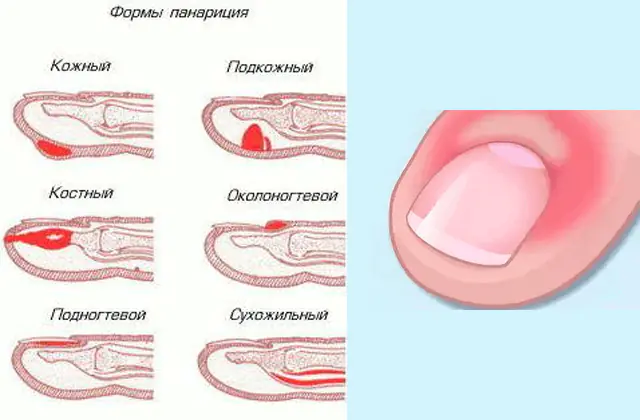
The main cause of panaritium on a finger is infectious agents entering a wound, scratch, ulcer or puncture. Most often it is Staphylococcus aureus or Streptococcus. Entrance gates for pathogenic microflora can be insect bites, splinters, scratches, and abrasions.
The following factors increase the risk of infection entering tissues:
- using low-quality soap or household chemicals that dry out the skin;
- habit of biting nails or fingertips;
- unprofessional manicure that injures the skin;
- use of immunosuppressants;
- chemotherapy and other treatment procedures that reduce immunity;
- chronic dermatological diseases (psoriasis, lupus, dermatitis);
- avitaminosis;
- diabetes;
- cold;
- endocrine diseases.
If felons often appear on your hands, you need to strengthen your immune system.
Symptoms and stages of felon on the finger
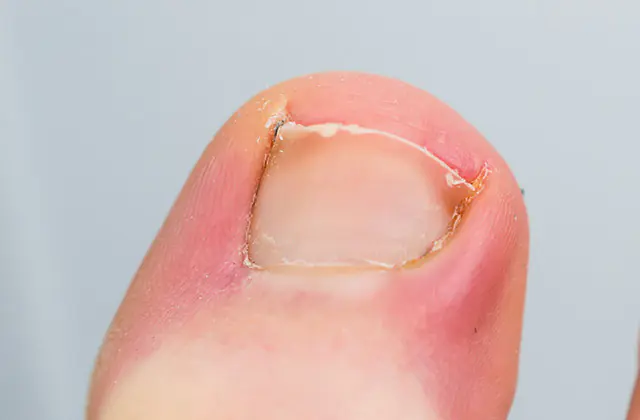
There are general signs by which you can distinguish a panaritium on a finger:
- throbbing, twitching pain in the area of inflammation;
- swelling, hyperemia;
- redness of the finger;
- enlarged lymph nodes in the inflamed area;
- general weakness;
- An abscess forms a blister containing purulent fluid.
Depending on how deep the infection has penetrated into the tissues, there are 3 stages of panaritium on the hand:
- Stage 1. The infection penetrates into the soft tissue. Sometimes signs of the disease are not felt.
- Stage 2. Pain, swelling, and redness occur.
- Stage 3. Formation of an abscess, abscess.
At the first and second stages, traditional treatment of panaritium of the finger is carried out. At the third stage, only surgical intervention is possible.
If the temperature rises against the background of swelling of the finger, this is a symptom of a deep infection that requires immediate intervention.
If you don’t know what to do if you have felon on your finger, first consult a therapist or dermatologist. To make a diagnosis in the early stages of the disease, a doctor only needs a visual examination. If doctors suspect deep-seated infection, an x-ray of the finger is prescribed to clarify the diagnosis.
Since swelling and redness in the early stages of the pathology do not appear on x-rays (the device only records the skeleton), sometimes the procedure has to be repeated after a couple of weeks. During this time, with traditional treatment, relief or localization of the source of inflammation occurs.
Methods for treating panaritium on a finger
The doctor determines how to treat panaritium on the arm based on the stage of the disease. In the first and second stages, drug therapy is used, including bandages with anti-inflammatory and antibacterial ointments, treatment with antiseptics, oral antibiotics, vaccination (if there is a risk of infection with tetanus or rabies). At the third stage, surgical intervention is used, since traditional treatment is considered ineffective.
Antibiotics for the treatment of felon on the arm
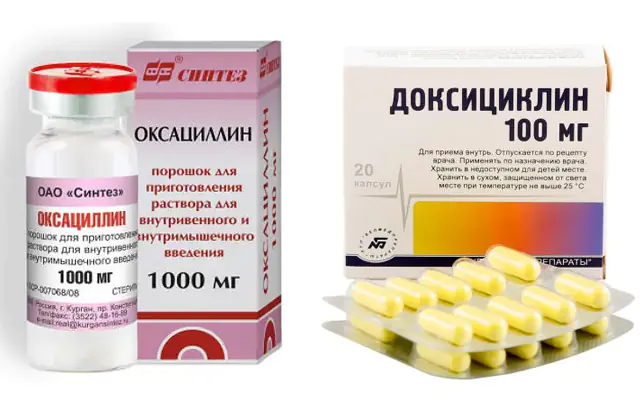
When felon occurs on a finger, antibiotics are used to neutralize pathogenic microflora and prevent further spread of the infection. Antibacterial medications are rarely prescribed orally. Most often, medications are administered intravenously or intramuscularly for a week.
The most common antibiotics for felon on the finger:
- Oxacillin. Powder for preparing a solution. The drug belongs to the semi-synthetic penicillins. It destroys microbial cells, acts against staphylococci and streptococci, gram-negative bacteria. Suitable for use in newborns and premature babies. The medicine has an extended list of side effects. Among the contraindications, the instructions mention sensitivity to the main substance. Price - 200 hryvnia or 500 rubles. Analogues: Oksamp, Oksamsar, Oxacillin-Ferein.
- Doxycycline. Semi-synthetic antibiotic of the tetracycline group. It inhibits bacterial protein synthesis. The product is active against a wide range of microorganisms. The medicine is contraindicated for people with kidney disease. The drug has an extended list of side effects. Price - 25 hryvnia or 50-60 rubles. Analogues: Doxilan, Vibramycin, Unidox Solutab.
- Clindamycin. Antibacterial agent from lincosamides. The drug inhibits the synthesis of proteins of microorganisms. This is a broad-spectrum medicine with a long list of side effects. Not recommended for children under 6 years of age. Price - 60 hryvnia or 150 rubles. Analogs: Lincocin, Lincomycin.
- Biseptol. Combined broad-spectrum antibacterial drug. The list of side effects is minimal. The drug is contraindicated in case of kidney and liver diseases, during lactation and pregnancy, in case of disruption of the cardiovascular system, in children under 1.5 months of age. Price - 50 hryvnia or 130 rubles. Analogs: Amoxicillin, Phthalazol, Sulfadimethoxine.
When selecting a drug for the treatment of felon on the arm, the individual characteristics of the patient’s body are taken into account.
Ointments for the treatment of felon on the finger
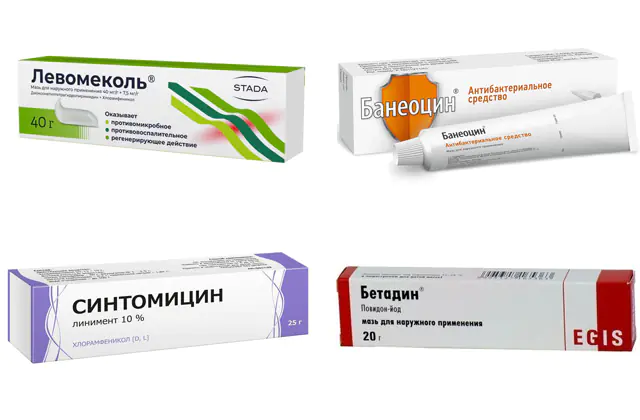
To reduce the activity of bacteria and accelerate the maturation of the abscess, use ointments for felon on the finger. They are applied to the wound in the form of an application 1-3 times a day.
Common medications include:
- Levomekol. Antibacterial ointment with chloramphenicol and methyluracil, active against gram-positive and gram-negative bacteria. The product penetrates cell membranes and accelerates regeneration. The drug is applied to bandages and applied to the abscess. Price - 20 hryvnia or 50-60 rubles. Analogs: Levomethyl, Levosin.
- Baneocin. Antibacterial ointment with bacitracin and neomycin, active against a wide range of microorganisms. Contraindicated for kidney disease and hypersensitivity. The ointment is applied to the wound, applying it to sterile napkins. Price - 120 hryvnia or about 300 rubles. Analogue: Bactroban.
- Sintomycin. Antibacterial ointment with chloramphenicol. The product prevents the proliferation of bacteria by inhibiting protein synthesis. Place under a bandage. Contraindications to the drug include eczema, fungal diseases, anemia, psoriasis, and hematopoietic disorders. Price - 18 hryvnia or 50 rubles. Analogue: Synthomycin liniment.
- Betadine. Ointment based on povidone-iodine. The product has a rapid bactericidal effect and is active against a wide range of microorganisms. The medicine is contraindicated in children under 1 year of age. Its advantage is that it has almost no side effects. Price - 90 hryvnia or 220 rubles. Analogue: Stellanin.
- Gentamicin. The ointment contains the substance of the same name and is a powerful broad-spectrum antibiotic. It disrupts the RNA and DNA of pathogenic bacteria, preventing them from reproducing. The only contraindications include hypersensitivity. Price - 50 hryvnia or 130 rubles. Analogs: Dexa-Gentamicin.
- Vishnevsky ointment. Antiseptic, anti-inflammatory agent. The composition includes xeroform, tar and castor oil. The ointment is regularly applied to the developing abscess for its speedy maturation. The medicine draws out the contents of the wound and promotes healing. Price - 20 hryvnia or 50 rubles. There are no direct analogs of the product.
- Ichthyol ointment. Analgesic, antiseptic, anti-inflammatory medication. It is produced on the basis of ichthyol - ammonium salt. The ointment is applied to the wound regularly throughout the day. Price - 22 hryvnia or 60 rubles. There are no direct analogues.
The selection of ointments for hand panaritium should be carried out by a doctor, since each of them has a targeted effect on the abscess.
Antiseptics for treating felon hands
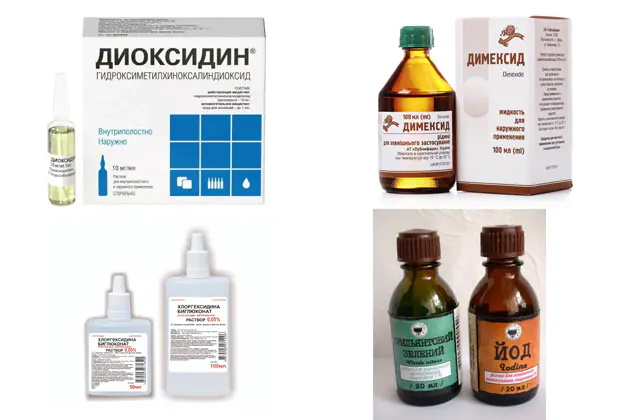
Antiseptic solutions are necessary to disinfect the inflamed area. They are used to wash the wound or make baths. However, antiseptics cannot cope with suppuration on their own. This is only an aid to speed up recovery.
Doctors recommend that if panaritium occurs on a finger, wash the wound with the following medications:
- Dioxidine;
- Dimexide;
- Chlorhexidine;
- hydrogen peroxide;
- iodine;
- brilliant green (zelenka);
- potassium permanganate, etc.
Potassium permanganate, Dimexide, Dioxidin are suitable for baths. The remaining drugs are applied directly to the affected area.
Physiotherapy for the treatment of felon hands
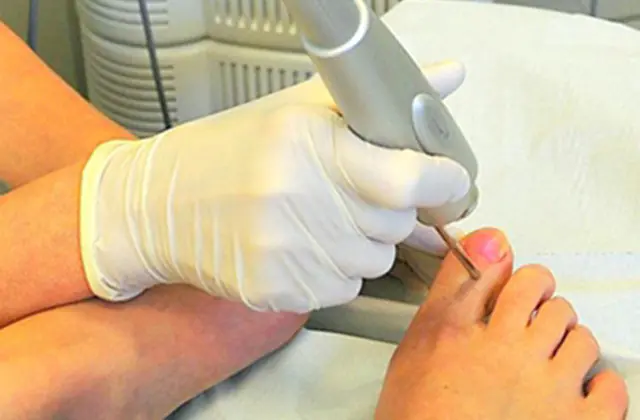
The photo shows laser treatment of felon
Before treating panaritium on a finger, the doctor prescribes a number of therapeutic measures. Along with medications, they resort to physiotherapy:
- Electrophoresis with sodium chloride. The method involves applying low-frequency electric current to the affected area. Together with it, ions of medicinal substances are delivered to the soft tissues. Thanks to physiotherapy, healing can be significantly accelerated. Sodium chloride draws out purulent contents without irritating the skin.
- Magnetotherapy. The treatment method involves exposing the diseased area to a magnetic field. It saturates tissues with oxygen, promotes the removal of excess fluid, and improves the condition of blood vessels and lymph nodes.
- Laser therapy. The method works for deep tissue lesions. The diode laser disinfects the abscess area, allows you to remove its contents without consequences and speed up recovery.
Physiotherapy is not the main means of treating panaritium.
Surgical intervention in the treatment of panaritium of the hand
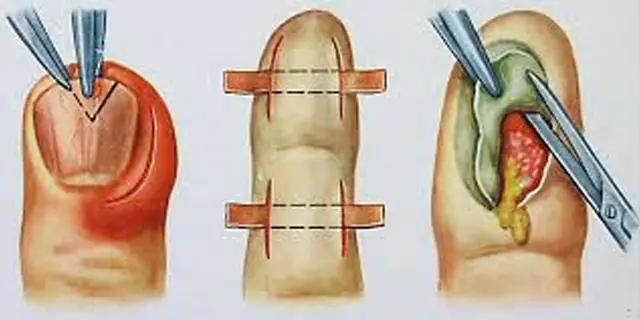
In complicated forms of the disease, surgery is prescribed for panaritium of a finger on the hand. There are several types of surgical intervention depending on the stage and type of pathology:
- Using scissors and other instruments, the surgeon peels off the dead epidermis and treats the wound with antiseptics. The procedure is performed without anesthesia.
- Lateral incisions of the inflamed area with subsequent drainage of purulent contents through a rubber outlet. This method is used for subcutaneous felon. Thanks to the operation, it is possible to quickly remove the fluid and avoid sticking of the edges of the wound.
- Cutting the nail above the surface of the abscess. The method “works” for subungual inflammation. The operation is performed under local anesthesia on an outpatient basis.
- With articular felon, antibiotics are injected into the joint. If recovery does not occur, the joint is opened and washed with antiseptics.
After surgery, the patient is regularly monitored by a doctor.
Folk remedies for felon on the finger
In the early stages, folk recipes give good results. They are aimed at drawing out purulent contents and disinfecting the wound.
Effective folk remedies for treating felon on the hand:
- Baths. A saline solution is best suited for this purpose. Take 1 tbsp. warm water and put 2 tsp in it. salt. Stir well and keep your finger in the solution for half an hour three times a day. A positive result is noticeable on the 3rd day.
- Aloe. Take an aloe leaf and grind it. Place the resulting pulp on a piece of bandage and apply to the abscess. Tie a compress and leave it overnight. Repeat daily until complete recovery.
- Garlic. Peel 2 cloves of garlic and chop them. Apply the paste to the wound and tie it with a bandage. Change the compress regularly 3-4 times a day. Garlic has powerful antiseptic properties.
- Propolis tincture. To treat felon on your arm at home, make compresses with tincture. Soak a gauze bandage in the indicated product and apply to the inflamed area. Change the compress 3-4 times a day.
- Onion gruel. Boil onions, chop and apply to the wound. Change the bandage regularly throughout the day.
Traditional recipes do not give quick results. However, with superficial panaritium at an early stage, they can prevent further infection and get rid of the problem.
Complications of felon on the finger
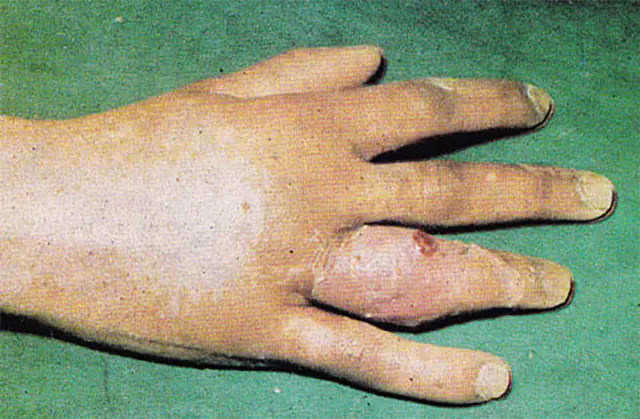
Developing inflammation must be treated. In the absence of therapy, complications of panaritium on the finger are possible:
- tissue necrosis;
- transition of mild types of panaritium to complicated ones;
- pandactylitis (inflammation of all tissues of the finger);
- sepsis;
- loss of finger functionality or amputation.
To prevent complications and prevent further inflammation, doctors recommend preventing panaritium:
- After using household chemicals and soap, apply moisturizer to your hands to prevent your skin from cracking due to dryness.
- Do not keep your hands in the water for long.
- Use rubber gloves when working around the house or in hazardous areas.
- Disinfect manicure tools or have cosmetic procedures performed by trusted professionals.
- In case of skin injuries, disinfect the wounds in a timely manner.
- Get rid of bad habits (biting your fingers, biting your nails, etc.).
By following these rules, you will reduce the risk of relapse of felon and speed up recovery. But if the disease develops, do not hesitate and immediately consult a doctor to prevent complications.
Video on how to quickly cure felon at home:



